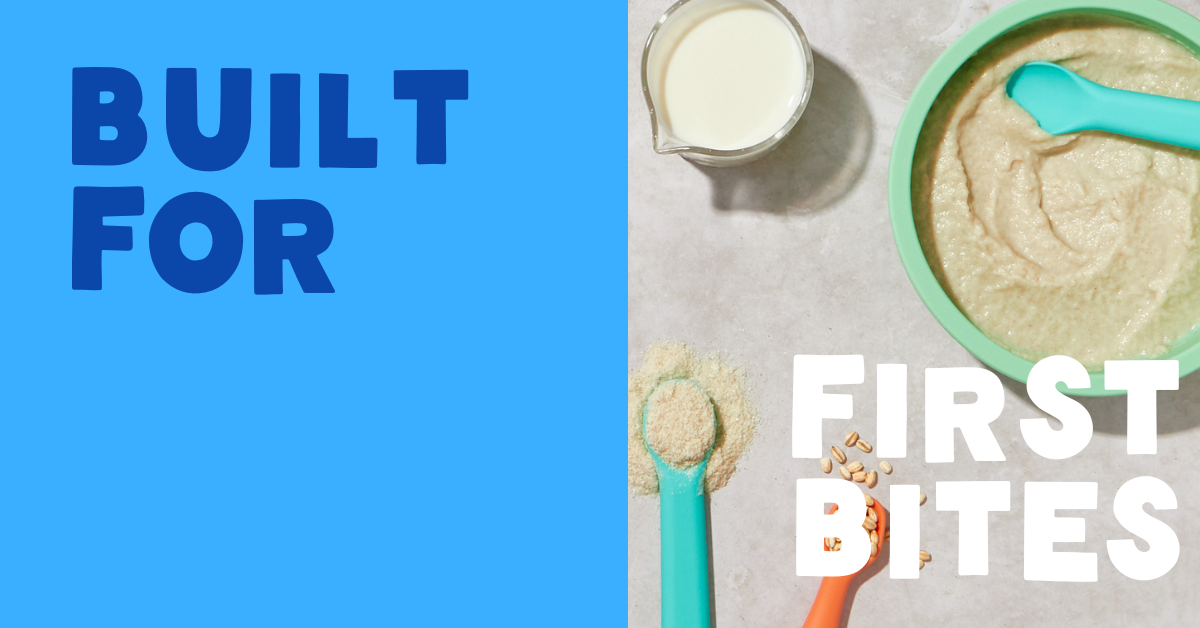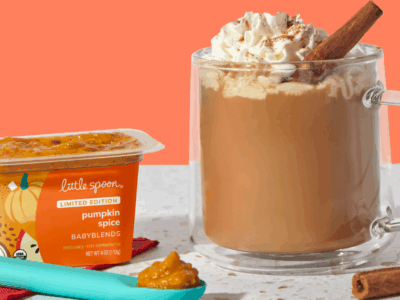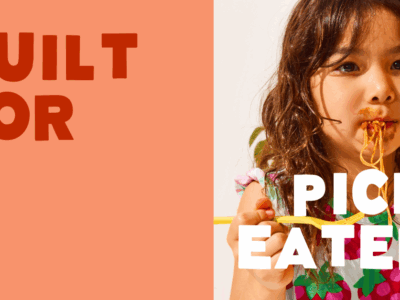Any parent from an earlier generation will likely tell you the same thing: baby cereal was the go-to first food for babies. For decades, grain-based cereals were practically a rite of passage for infants starting solids and they formed the nutritional foundation of a baby’s early diet. Spoonful by spoonful, baby oatmeal cereal became a trusted staple on every baby feeding chart.
While feeding practices have evolved (hello, avocado and baby-led everything!), baby cereal still plays an important role in infant nutrition. It may no longer be the only option, but that doesn’t mean it’s outdated or unnecessary. Whether you’re just starting solids or looking to round out your baby’s meals, we’re sharing how baby cereal can be a nutritious and reliable staple on their plate.
Benefits of baby cereal
Baby cereal has been a go-to first food for generations. Here’s why it still works:
- It’s baby-friendly: The smooth, soft texture is perfect for infants who are learning to eat from a spoon. It’s gentle on tiny mouths, easy to swallow, and helps ease the transition from a liquid-only diet to solid foods.
- It’s packed with nutrients: Baby cereals provide carbohydrates (our body’s preferred source of energy) and essential vitamins and minerals. Around 6 months, breast milk and formula alone no longer meet all of an infant’s nutritional needs, and baby cereal can help fill in those gaps.
- It’s iron-fortified: Around 6 months of age, babies’ iron stores start to run low. That’s why it’s important to introduce iron-rich foods at this stage. Most baby cereals are iron-fortified, making them an easy and effective way to support your baby’s growth and brain development.
- It has a mild taste: Infant cereal is bland and neutral and it’s easy for most babies to accept, especially when mixed with familiar flavors like breast milk or formula.
- It’s versatile and customizable: One of the best things about baby cereal is how easy it is to mix with other foods. Combine it with mashed or pureed fruits, veggies, or protein to amp up nutrition and introduce new flavors and textures.
- It’s convenient: Whether you’re feeding one baby or five, baby cereal is a reliable, fuss-free staple to keep in your diaper bag. It’s quick to prepare, easy to pack, and great for mealtime at the park, grandma’s house, or wherever the day takes you.
Why do babies need iron?
Let’s talk iron—because it’s a pretty big deal around the 6-month mark. At this age, a baby’s iron needs jump to 11 milligrams a day to support their growing bodies. To put that in perspective, that’s roughly the same amount of iron you’d find in a whole cup of white beans AND 1.5 ounces of beef liver. Yeah, that’s a lot for anyone, let alone a baby who’s just learning how to eat solids.
And here’s the thing, at this stage, babies are only eating a few spoonfuls at a time. Their bellies are tiny, and it’s totally normal for them to take it slow and eat small amounts during the early days of solid foods. That’s where iron-fortified baby cereals come in: just a few tablespoons can pack in over half of their daily iron needs. It’s a super practical way to get in iron without expecting them to eat a mountain of pureed beans and liver.
A quick word about rice cereal for babies vs oatmeal cereals
Rice has traditionally been the primary grain in many iron-fortified baby cereals. That’s because it’s easy to digest, generally well-tolerated, and not considered a common allergen. But if you’ve been following the headlines, you may have seen concerns around heavy metals, particularly arsenic, in rice-based products.
Here’s what’s going on: arsenic is a naturally-occurring heavy metal found in soil and water, but it can also enter the food supply through environmental pollution and farming practices. Rice, in particular, tends to absorb more arsenic than other grains, because it absorbs it from the soil and water it’s grown in.
Over time, toxic exposure to heavy metals like arsenic can pose significant health risks to babies and young children, potentially affecting their growth and development. This doesn’t mean you need to cut out rice cereal entirely—but it’s a good idea to serve it in moderation and focus on offering a variety of whole foods to help reduce the risk of unintended exposure.
This is one reason why parents and pediatric healthcare professionals prefer baby oatmeal cereal. It’s still gentle on digestion, well-tolerated, iron-fortified, and generally contains lower levels of arsenic compared to rice cereals.
How to introduce your baby to baby cereal
So, you’re ready to introduce your little one to baby cereal—how exciting (and yep, it’s about to get adorably messy)! But before you grab the bib and camera, let’s talk about when to get started. According to the American Academy of Pediatrics (AAP), most babies are ready to begin solid foods around the 6-month mark. At this age, babies start showing signs that they’re developmentally ready for solid food, such as:
- Sitting up with minimal support
- Steady head control
- Bringing hands and toys to their mouth
- Showing interest in what you’re eating (like staring at your cheesy pizza or reaching for your taco salad)
You can introduce baby cereal using two different approaches, and both are totally valid: either traditional spoon-feeding, where you feed your baby with a spoon, or baby-led weaning (BLW), where you offer your baby a preloaded spoon and let them take the lead at mealtime. Baby cereal works well with either method, so choose what feels right for you and your baby.
Mixing infant cereal
Check the instructions on your chosen baby cereal for the right cereal-to-liquid ratio. You can mix it with breast milk, baby formula, or water. If the cereal seems too runny, add a little more cereal, and if it’s too thick, add a bit more liquid. Getting the texture just right might take a few tries, but that’s all part of the learning curve.
How to offer infant cereal
- If you’re spoon-feeding: Start with just a small amount on the spoon. Bring it to your baby’s mouth and wait for them to open up. Start off with a small amount since this is a new experience and it takes time for babies to figure out how to move food off the spoon, close their lips, and swallow something with a different texture than milk.
- If you’re doing baby-led weaning: Offer your baby a preloaded spoon with a thicker consistency of cereal so it better sticks to the spoon. Spoons made for self-feeding often have ridges or grooves to help hold the food. Hand your baby the spoon and let them explore. Sure, it might get messy (okay, it definitely will), but that’s all part of the fun.
What to expect
If this is your baby’s first try with solid food, don’t be surprised if they only eat a couple of spoonfuls or none at all (you can still check it off the baby feeding chart!). This is a new sensory experience for them so spitting out food or gagging is completely normal.
Tips for success
- Pick a time of day when your baby isn’t too tired and is a little hungry (but not hangry!).
- If your baby isn’t interested in plain baby cereal, mix in mashed fruits, veggies, or pureed chicken or lentils.
- Doing baby-led weaning? You can incorporate infant cereal into soft, baby-friendly pancakes or waffles.
- As your baby gets comfortable with solids, you can stir in common allergens like thinned peanut butter or almond butter or mashed, fully cooked scrambled eggs.
- Be mindful of your baby’s hunger and fullness cues. Babies are excellent at regulating their appetite, so follow their cues instead of trying to feed them a specific amount.
- Keep mealtimes relaxed. Babies can sense when you’re stressed, so aim for a calm and positive feeding vibe.
How to choose the best baby cereal for your baby
Now that you’ve got a handle on the why and how of baby cereal, let’s talk about choosing the right one, because not all baby cereals are created equal. Here’s what to look for:
- Choose a grain-type: Avoid rice-based cereals as rice contains higher levels of heavy metals like arsenic. Instead, select a baby oatmeal cereal or multi-grain cereals (think oats, millet, barley, quinoa) which offer more vitamins, minerals, and fiber.
- Check the iron content: Look for a baby cereal that provides 5 to 6 milligrams of iron per serving, which helps meet about half of your baby’s daily iron needs.
- Look for high-quality manufacturing standards: Look for brands that undergo third-party testing to ensure purity, safety, and quality. This gives you peace of mind that what you’re feeding your baby is free from harmful chemicals, pesticides, and unnecessary contaminants.
- Consider allergen-free options: When you’re just starting solids and slowly introducing potential allergens (like peanuts, eggs, or dairy), it’s helpful to start with a neutral, allergen-free cereal. That way, you’ll know if a reaction is coming from the new food you’re testing.
- No added sugar: Babies don’t need any added sugar, and the AAP recommends zero added sugars before age 2. Always check the label for hidden sources of added sugar (like corn syrup or rice syrup) to help build healthy eating habits.
Why Little Spoon’s baby cereal is actually the best choice
While we have you, let us explain why Little Spoon’s Organic Oatmeal Baby Cereal is the top choice for babies. Here’s what makes it a clear winner:
- Grain type: Little Spoon’s baby oatmeal cereal is made with oats, barley, and millet, and absolutely no rice. That means lower exposure to heavy metals and 2 grams of fiber to help keep things moving in the bathrooms department (if you know, you KNOW).
- Iron content: Each serving packs 5.5 mg of iron to support your baby’s growth and development.
- High-quality manufacturing standards: Little Spoon goes above and beyond, and tests for heavy metals like lead, mercury, cadmium, and arsenic, along with 551 other toxins and contaminants. It’s USDA Organic, has the Clean Label Project Purity Award, and Little Spoon is the only baby food brand with publicly available testing standards. That’s some real peace of mind.
- Allergen-free: Completely free of the top nine allergens, which makes it a great choice when you’re just starting out with solids.
- Zero added sugar: Like, none. Zilch. Which is exactly what your baby’s growing body needs.
- BONUS nutrients: You’re also getting 2 grams of protein, 2 micrograms of vitamin D, 1 milligram of zinc, and 80 milligrams of calcium per serving. Not bad for a bowl of baby cereal!
- Delivered to your door: With a flexible subscription, Little Spoon brings it right to your doorstep. No last-minute grocery store runs, no hassle, and no babysitter.
- Pair with other Little Spoon blends: If you want to give your baby’s cereal a flavor and texture upgrade, Little Spoon has you covered. They offer a wide variety of Babyblends—from Stage 1 (ultra-smooth) to Stage 5 (chunkier and more complex)—so you can mix and match based on your baby’s age and eating stage. You can also try Babyblends+ pouches, which are superfood-packed purees with functional ingredients (like omega-3 fatty acids, choline, vitamin C, zinc, and probiotics), designed to support brain development, digestion, and immune development.
FAQs
Can you put baby cereal in a bottle?
In short, no. While this was common practice back in the day (because it was believed to help babies sleep or reduce spit up), we now know that adding baby cereal to bottles isn’t safe. It can increase the risk of choking and aspiration (when food or liquid enters the lungs) and may lead to overfeeding.
Do babies need infant cereal?
No, babies don’t need baby cereal in order to grow and thrive. At 6 months, most of their calories should still come from breast milk and/or formula, with solid foods serving as a complement to milk feeds (if you need help getting started, here’s a sample baby feeding chart to help you build a daily schedule.) And if you’re wondering how long do babies drink formula or breast milk—typically, until around 12 months of age.
That said, baby cereal is still a practical, nutritious option, and can easily be included as part of your baby’s meals. Like all first foods, it’s best to offer it alongside a variety of other textures and flavors to help your baby develop a well-rounded, balanced diet.
What is Little Spoon’s baby cereal tested for?
In the U.S., there are no federal regulations requiring companies to test baby food for harmful contaminants. That’s why Little Spoon takes extra steps to ensure safety and proactively tests all products to ensure they fall below the recommended thresholds for:
- Arsenic
- Lead
- Cadmium
- Lead
- Glyphosate
- Pesticides
- Plasticizers (BPA and BPS)
How do I incorporate baby cereal into my baby’s schedule?
You can start by offering baby cereal once a day, ideally at a time when your baby is not overly hungry or tired. Many parents find early-morning works well as their baby is typically in a good mood after some restful zzzs. To help you get started, here’s a sample formula feeding chart for a 6-month-old baby that includes baby cereal:
Infant feeding chart
- 6:00 AM: Wake up + milk feed
- 7:00 AM: Baby cereal (mixed with formula)
- 8:00 AM: Nap #1
- 9:00 AM: Milk feed
- 12:00 PM: Milk feed
- 2:00 PM: Nap #2
- 3:00 PM: Milk feed
- 6:00 PM: Milk feed and bedtime



